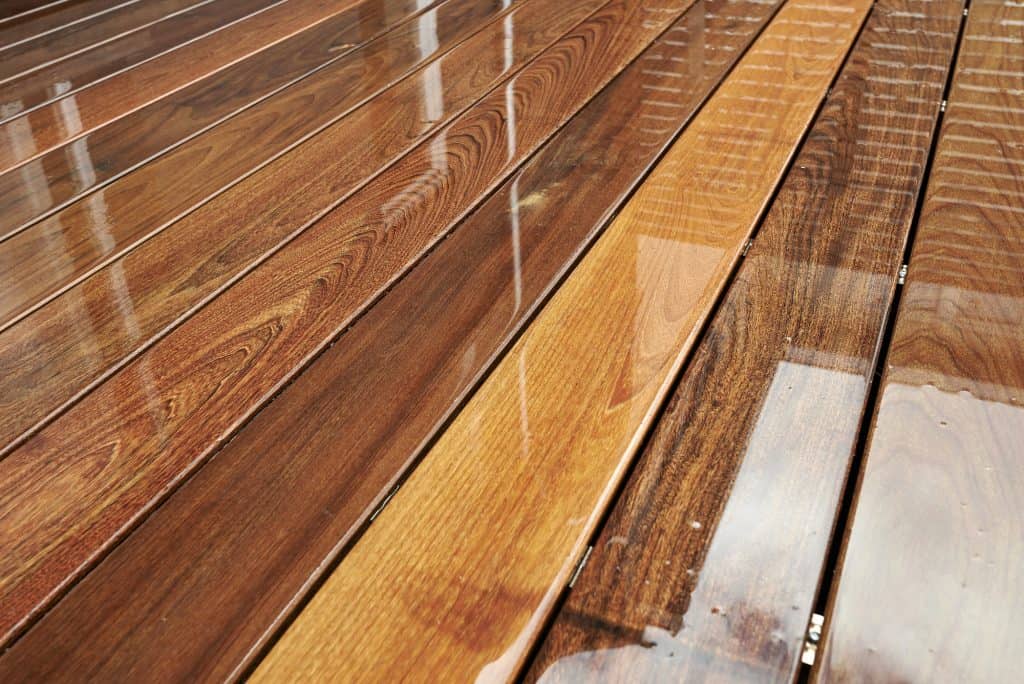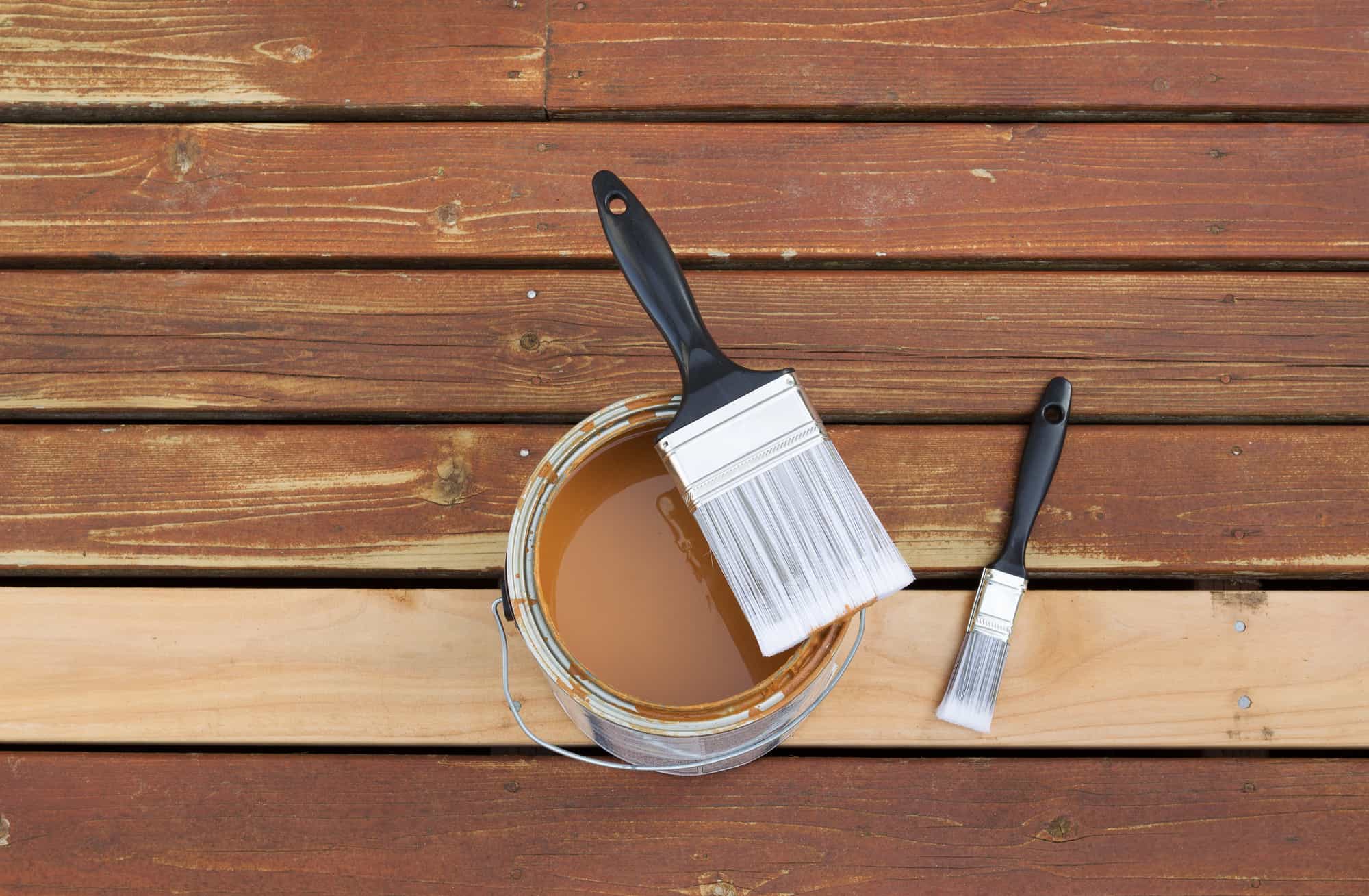It is spring, and it is time to breathe some life into your wood deck. Like every savvy homeowner, you have a deck sealer supply in storage to ensure regular deck maintenance; after all, it is economical to purchase deck sealer in bulk than it is to buy it in multiple small tins.
That said, how long will leftover wood stain last?
Generally, old deck stains go bad when you expose them to extreme temperatures. Air, light, and moisture can also cause degradation during storage. Different deck stains have a diverse range of shelf lives. If you have a can of old deck stain, you can extend its shelf life through proper storage.
The shelf life of a can of stain depends on its constituents. In this article, we’ll delve into different wood stains and their shelf lives. We’ll also discuss factors that can make old deck stains degrade before its time.
Factors That Cause Old Deck Stain to Degrade
Exposure to Air Will Speed Up Deck Stain Decay
A can of penetrating oil stain can last six years when new. It will keep fresh three years after you have opened it. The time that your stain will last without breaking down depends on the amount of air that you expose it to.
When in storage, ensure that your wood stain has an airtight seal. Keeping air out of the can keeps bacteria and moisture from degrading the components of the wood stain.
If you have any leftover wood stain, wipe off the rim of the can after use.
When sealing it, squeeze the can tightly. If you do not sense any air escaping, then the seal is tight enough. If the lid is the screw-on type, clean it with a finish solvent, then spread Vaseline on its threads to keep the lid from gluing on tightly.
Alternatively, use plastic wrap or wax paper to wrap the screw-on lid and prevent stickiness. Should you leave room for air circulation, your penetrating oil stain or varnish will turn to a crust and undergo oxidation, rendering it unusable.
Some homeowners empty their bulk varnish into a smaller pint or quart to prevent oxidation and then vacuum seal them for future use. This does away with the room with an oxygen holding area between the lid and the stain.
If you do not have some empty mason jars at hand, add stones or marbles into your large can of wood stain to raise the contents’ level. Place a plastic wrap atop the stain layer, then seal the lid tightly.
Temperature Extremes Will Speed Up Deck Stain Decay

When storing your leftover wood stain, ensure that the area of storage has temperature control.
Extreme heat or cold will ruin a good stain. If you leave it to freeze, there are high chances that the freeze and thaw cycles will affect the stain’s chemical structure.
Unheated spaces in winter will freeze water-based stains forming ice crystals in them. Therefore, the components of the stain will separate, and even the most thorough mixing and blending might not restore the stain’s consistency.
Should your stain freeze, thaw it slowly at room temperature. If you speed up the process by heating the can, you could heat volatile components or make the stain unusable.
After thawing the product, mix it, and check for signs of degradation before use.
Light and Moisture Can Lower the Quality of Your Wood Stain
Some products can be sensitive to light, so you will have to store them in opaque containers should you have any leftovers.
The presence of moisture during storage can encourage the growth of microorganisms, breaking down your wood stain.
The Shelf Life of Various Types of Wood Stains
Oil Wood Stains
Oil-based stains can give your wooden deck the most amazing finish. These penetrating oils come in stain and clear variations, giving wood a simple finish that preserves its natural allure.
The oil wood stain will preserve all the subtle flaws and knots on the grain to highlight your deck’s character.
Most homeowners that go oil stain colors never look back. These stains are also easy to apply and are very durable. They are resistant to water damage and scratches as well. They will seep deep into the porous wood, sealing it for protection, leaving a little sheen or gloss on the surface.
Staining your wood deck will also protect your deck from fungus and insect attacks. It will also protect it from ultraviolet ray damage.
Unlike paint, which has a binder and pigment, these stains are a dye that dissolves in a translucent or transparent agent.
The penetrating oil stain uses mineral or petroleum spirit as its solvent. The spirit eases the rigors of application and enhances the stain’s viscosity. This is the reason oil stains are highly combustible.
If you soak rags in oil stains and leave them out in the sun after application, they will spontaneously combust!
Always observe safety when dealing with oil wood stains. There are oil wood stains that have tung or linseed oil as binders. The most common pigment in oil wood stain is iron oxide.
They also have thickening agents and metallic salts that increase oxidation and drying of the stain on application. Oil on wood stains can last a long time, so you should not throw away any deck stain leftover.
Some brands might not have a “Best By” date, but the rule of thumb is that a new can will last up to six years.
The leftover can will be usable a year or three years down the lane. One factor that significantly affects the life of a wood stain is its storage conditions.
Varnish Wood Stains
Varnishes are clear liquid preparations that have a lot in common with oil-based stains. The major difference between the penetrating oil stain and varnish is that the latter dries hard.
Varnish stains use the resin as the binding agent, rendering the wooden deck hard, shiny, and clear after application.

The natural varnish has a natural resin and an oil base. Its solvent may be mineral spirit or turpentine. There are, however, exterior and synthetic polyurethane varnishes on sale that give flat, glossy, or satin finishes.
Most varnishes can last a decade or two, but the satin finish type breaks down faster. An open gallon of synthetic varnish has a shorter life span than a new can does.
You can easily tell spoilt varnish by the large topcoat at its top and chunks of hard gel that mess up your woodwork.
To prolong the shelf life of varnish, eliminate any air from the can to keep it from curing. Seal the tin as tightly as possible.
Water-Based Wood Stains
Water-based wood stains dry faster than their penetrating oil counterparts do. They are perfect for coloring large decks. Their stains are also softer. The older water-based stains do not have binders, allowing successive coat application.
The newer formulations have acrylic polymers in them.
You can use water as a thinner, so they are less irritable and volatile than oil-based stains. A water-based stain has a three-year shelf life when new.
With proper storage, leftover water-based stains are still usable after a year in storage.
Conclusion
Old deck stains will go bad if you store them poorly. Exposure to moisture, air, extreme temperatures, and light can be detrimental to a can of wood stain’s durability.
Observe safety when storing your wood stain. Save the can on a top shelf to protect kids and pets. Ensure that the stain is free from any fire hazards since most wood stains have volatile and flammable chemical components.
Sources
- NYTimes: HOME CLINIC; The Types and Uses of Wood Stain
- Made How: Wood Stain
- Bob Vila: Paints and Finishes
- Creator Skills: How Long Does Wood Stain Last in the Can?
- Rockler: How to Determine if Wood Finish, Varnish, and Oils Have Expired and Extend or Dispose of Them
- The Wood Whisperer: Polyurethane Shelf Life
- General Finishes: What is the best way to store water-based finishes?
- Permachink: Is It Okay to Let Stains and Sealants Freeze?

